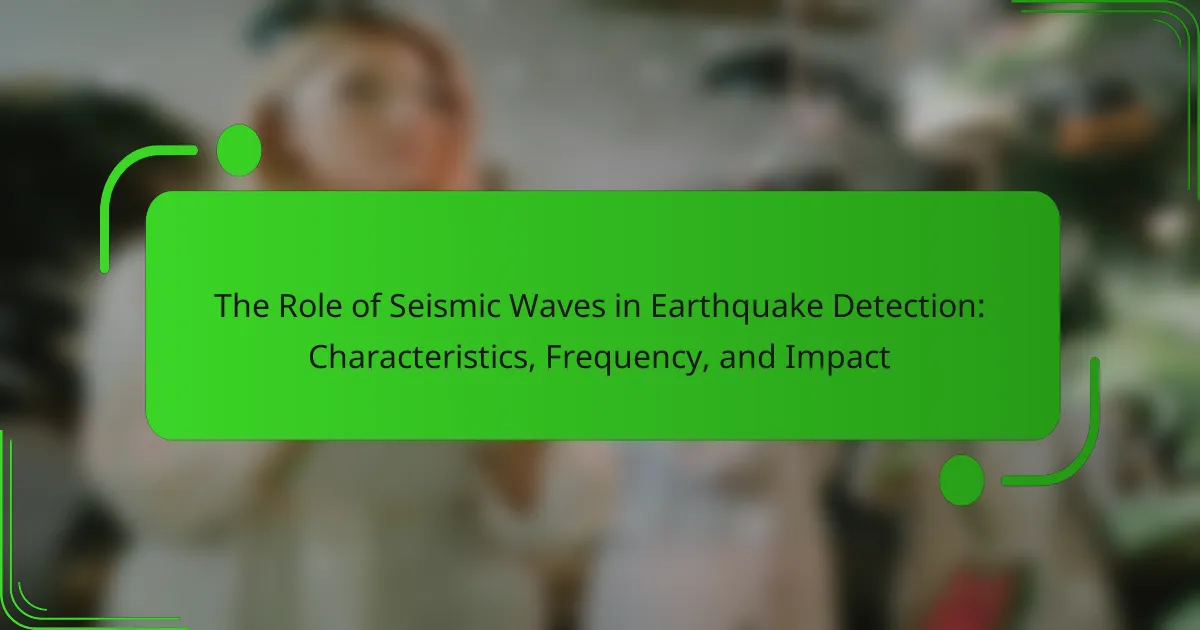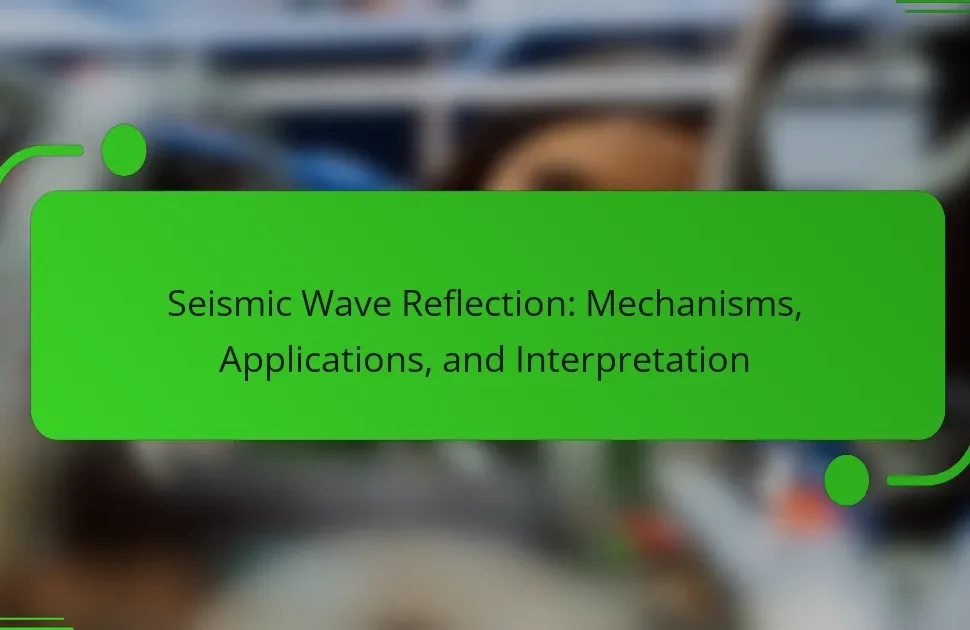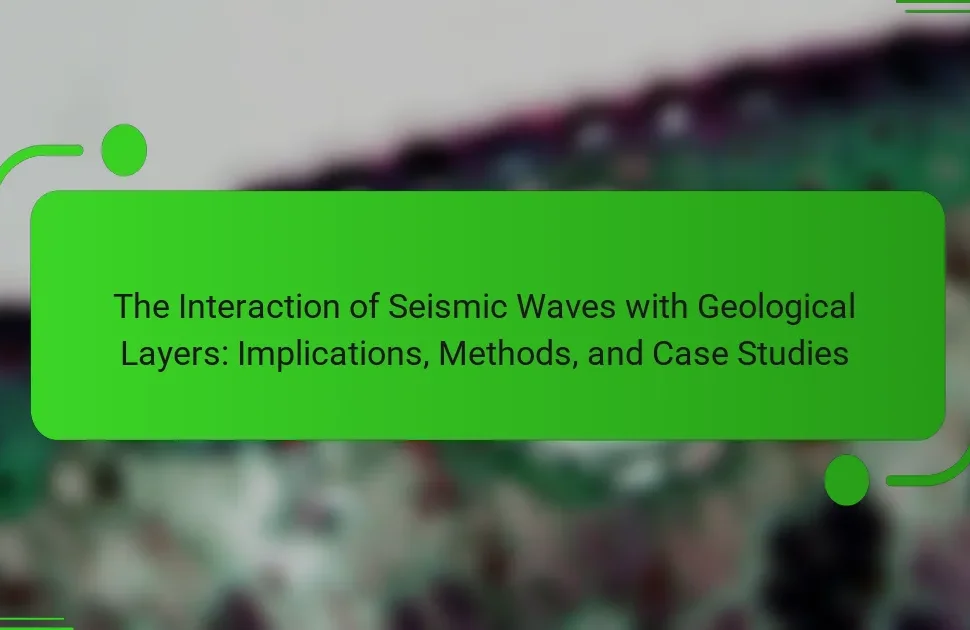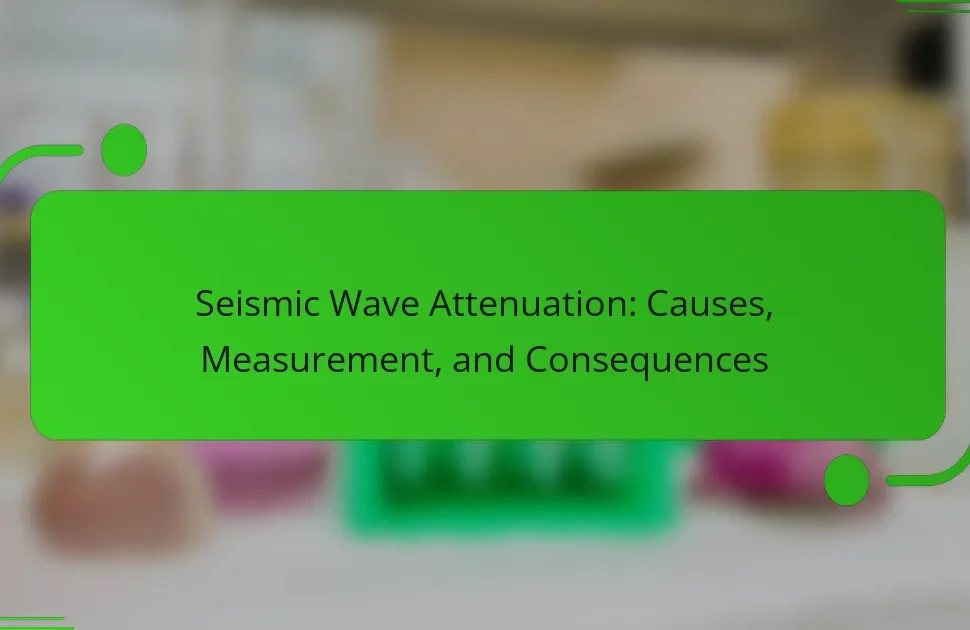Seismic waves are energy waves generated by the sudden release of energy in the Earth’s crust, primarily during earthquakes. These waves are classified into two main types: primary (P) waves, which are faster and can travel through solids and liquids, and secondary (S) waves, which are slower and only move through solids. Additionally, surface waves travel along the Earth’s surface and are typically responsible for the most damage during seismic events. The characteristics of seismic waves, including their speed, frequency, and amplitude, are crucial for seismologists in determining the epicenter and magnitude of earthquakes, ultimately aiding in risk assessment and improving early warning systems. Understanding the frequency and impact of these waves is essential for earthquake preparedness and effective building design.
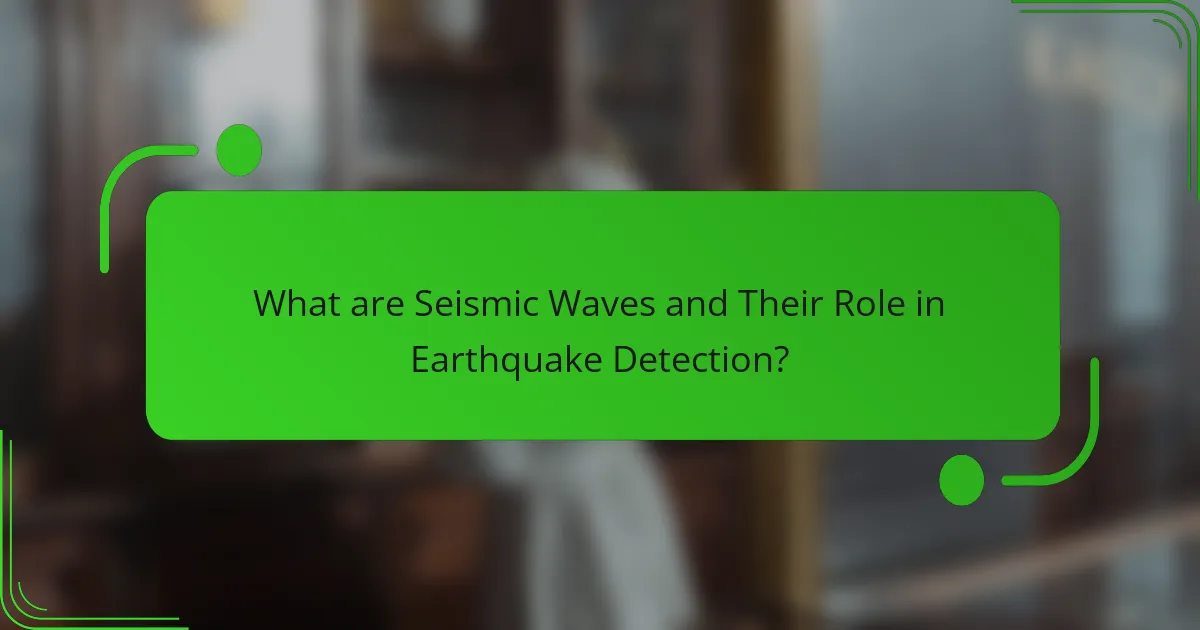
What are Seismic Waves and Their Role in Earthquake Detection?
Seismic waves are energy waves generated by the sudden release of energy in the Earth’s crust, typically during an earthquake. They travel through the Earth and are classified into two main types: primary (P) waves and secondary (S) waves. P waves are compressional waves that move faster and arrive first at seismic stations. S waves are shear waves that follow P waves and arrive later.
Seismic waves play a crucial role in earthquake detection. They are detected by seismographs, which measure the ground motion caused by these waves. The time difference between the arrival of P waves and S waves helps seismologists determine the earthquake’s epicenter.
Additionally, the amplitude and frequency of seismic waves provide information about the earthquake’s magnitude. For instance, larger amplitude waves indicate a more powerful earthquake. This data is essential for assessing earthquake risks and improving early warning systems.
In summary, seismic waves are fundamental to understanding and detecting earthquakes, providing critical data that enhances safety and preparedness.
How do seismic waves generate during an earthquake?
Seismic waves generate during an earthquake due to the sudden release of energy in the Earth’s crust. This release occurs when accumulated stress exceeds the strength of rocks. As rocks break or slip along faults, they create vibrations that propagate through the Earth. These vibrations travel in the form of seismic waves. There are two main types of seismic waves: primary (P) waves and secondary (S) waves. P waves are compressional and travel fastest, while S waves are shear and arrive later. The energy released during an earthquake can be measured using seismographs. These instruments detect the arrival times and amplitudes of seismic waves, allowing scientists to analyze the earthquake’s characteristics.
What types of seismic waves are there?
There are two primary types of seismic waves: body waves and surface waves. Body waves travel through the Earth’s interior and are further divided into primary (P) waves and secondary (S) waves. P waves are compressional waves that move faster than S waves. S waves are shear waves that can only travel through solids. Surface waves travel along the Earth’s surface and are responsible for most of the damage during an earthquake. They include Love waves and Rayleigh waves. Love waves move horizontally, while Rayleigh waves roll along the ground. These distinctions are crucial for understanding how seismic waves affect structures during earthquakes.
How do seismic waves travel through different materials?
Seismic waves travel through different materials by varying speeds and modes of propagation. In solids, seismic waves move faster than in liquids or gases. For example, P-waves, or primary waves, can travel through both solids and liquids, while S-waves, or secondary waves, only propagate through solids.
The density and elasticity of the material affect the speed of these waves. Denser materials typically allow seismic waves to travel faster. For instance, seismic waves travel at approximately 5.5 kilometers per second in granite, while in water, they travel at about 1.5 kilometers per second.
Additionally, the type of wave influences how it interacts with materials. P-waves compress and expand the material in the direction of travel, while S-waves shear the material perpendicular to their direction. This difference in motion leads to varying effects on structures and geological formations.
Understanding these principles is crucial for earthquake detection and assessing potential damage.
Why are seismic waves crucial for detecting earthquakes?
Seismic waves are crucial for detecting earthquakes because they provide real-time data about the location and magnitude of seismic events. These waves travel through the Earth and can be detected by seismometers. Seismometers measure the vibrations caused by seismic waves, allowing scientists to analyze their characteristics. There are two main types of seismic waves: primary (P) waves and secondary (S) waves. P waves are faster and arrive first, while S waves follow and cause more damage. By analyzing the arrival times and patterns of these waves, scientists can determine the epicenter of an earthquake. This information is vital for issuing warnings and understanding seismic activity. Historical data shows that seismic wave analysis has been instrumental in earthquake research since the development of modern seismology in the late 19th century.
What information can seismic waves provide about an earthquake’s location?
Seismic waves provide critical information about an earthquake’s location. They help determine the epicenter, which is the point on the Earth’s surface directly above where the earthquake originates. By analyzing the arrival times of different types of seismic waves, such as P-waves and S-waves, seismologists can triangulate the earthquake’s source. The difference in arrival times between these waves at various monitoring stations allows for accurate calculations of the distance to the epicenter. This method is supported by the fact that P-waves travel faster than S-waves. Seismographs record these waves, enabling precise location mapping. The data from multiple stations is essential for confirming the earthquake’s coordinates.
How do seismic waves help in determining earthquake magnitude?
Seismic waves help in determining earthquake magnitude by measuring the energy released during an earthquake. Seismographs detect these waves and record their amplitude and frequency. The amplitude of seismic waves correlates with the earthquake’s energy release. Higher amplitudes indicate stronger earthquakes. The magnitude is calculated using the logarithmic scale, specifically the Richter scale or moment magnitude scale. These scales provide a numerical representation of the earthquake’s size. For example, a magnitude 6 earthquake releases about 31.6 times more energy than a magnitude 5 earthquake. This relationship allows scientists to assess the earthquake’s impact and potential damage.

What are the Characteristics of Seismic Waves?
Seismic waves are energy waves generated by the sudden release of energy in the Earth. They travel through the Earth and are a key component in understanding earthquakes. There are two primary types of seismic waves: body waves and surface waves. Body waves include P-waves and S-waves. P-waves are compressional waves that travel fastest and can move through solids and liquids. S-waves are shear waves that only travel through solids and are slower than P-waves. Surface waves travel along the Earth’s surface and typically cause the most damage during an earthquake. They have lower frequencies and longer wavelengths than body waves. The characteristics of seismic waves include their speed, frequency, amplitude, and the medium through which they travel. These characteristics help seismologists determine the location and magnitude of earthquakes.
What are the main attributes of seismic waves?
Seismic waves have several main attributes. These include their type, speed, frequency, and amplitude. There are two primary types of seismic waves: body waves and surface waves. Body waves consist of P-waves (primary waves) and S-waves (secondary waves). P-waves travel faster than S-waves, typically at speeds of 5 to 8 km/s in the Earth’s crust. S-waves are slower, traveling at about 3 to 4.5 km/s.
The frequency of seismic waves can vary significantly, often ranging from 0.01 Hz to 100 Hz. Higher frequency waves tend to cause more damage during earthquakes. Amplitude refers to the height of the wave, which correlates with the energy released during an earthquake. Larger amplitudes indicate more powerful seismic events. These attributes are essential for understanding how seismic waves propagate and their impact on structures during an earthquake.
How do the speed and frequency of seismic waves vary?
The speed and frequency of seismic waves vary inversely. As the speed of seismic waves increases, their frequency decreases. Seismic waves include primary waves (P-waves) and secondary waves (S-waves). P-waves travel faster than S-waves, typically at speeds of 5 to 8 kilometers per second. S-waves travel at speeds of about 3 to 4.5 kilometers per second. Higher frequency waves have shorter wavelengths. Lower frequency waves have longer wavelengths. This relationship is governed by the wave equation, where speed equals frequency multiplied by wavelength. Thus, changes in one attribute directly affect the other.
What is the significance of wave amplitude in earthquake detection?
Wave amplitude is significant in earthquake detection as it indicates the energy released during an earthquake. Higher wave amplitudes correlate with stronger earthquakes. Seismographs measure these amplitudes to determine the earthquake’s magnitude. The Richter scale quantifies this magnitude based on wave amplitude measurements. For example, a magnitude 5 earthquake has a wave amplitude ten times greater than a magnitude 4 earthquake. This data helps in assessing potential damage and guiding emergency responses. Accurate amplitude readings are crucial for understanding seismic activity and improving safety measures.
What factors influence the characteristics of seismic waves?
The characteristics of seismic waves are influenced by several factors. These factors include the type of seismic wave, the medium through which they travel, and the source of the seismic activity.
Seismic waves can be primary (P-waves) or secondary (S-waves). P-waves travel faster and can move through solids and liquids, while S-waves only move through solids. The properties of the geological materials affect wave speed and amplitude.
The density and elasticity of the medium impact how seismic waves propagate. Denser materials generally transmit waves more efficiently. The depth of the seismic source also influences wave characteristics. Shallow sources produce higher frequency waves, while deeper sources generate lower frequency waves.
Additionally, geological structures such as faults and layers can reflect and refract seismic waves. This interaction alters the wave’s characteristics as they travel. Understanding these factors is essential in earthquake detection and analysis.
How do geological formations affect seismic wave propagation?
Geological formations significantly influence seismic wave propagation. The composition and structure of these formations determine how waves travel through the Earth. For instance, seismic waves travel faster in solid rock compared to softer sediments. Variations in density and elasticity within geological layers can cause reflections and refractions of seismic waves. These changes affect the amplitude and speed of the waves. Additionally, geological features like faults or fractures can disrupt wave paths. Studies have shown that complex geological settings can result in significant variations in wave intensity. This variability can affect the accuracy of earthquake detection and analysis.
What role does depth play in seismic wave characteristics?
Depth significantly influences seismic wave characteristics. As seismic waves travel through the Earth, their speed and behavior change with depth. In general, seismic waves travel faster in denser materials found at greater depths. For instance, primary waves (P-waves) can reach speeds of about 6 to 8 kilometers per second in the Earth’s crust, while they can exceed 13 kilometers per second in the mantle. Additionally, the type of seismic wave that propagates can vary with depth. Surface waves typically occur near the Earth’s surface, while body waves penetrate deeper layers. The depth also affects the attenuation of seismic waves. As waves travel deeper, they may lose energy due to interactions with geological materials. This attenuation can alter wave amplitude and frequency, impacting the signals detected by seismographs. Overall, depth plays a crucial role in determining the velocity, type, and attenuation of seismic waves.
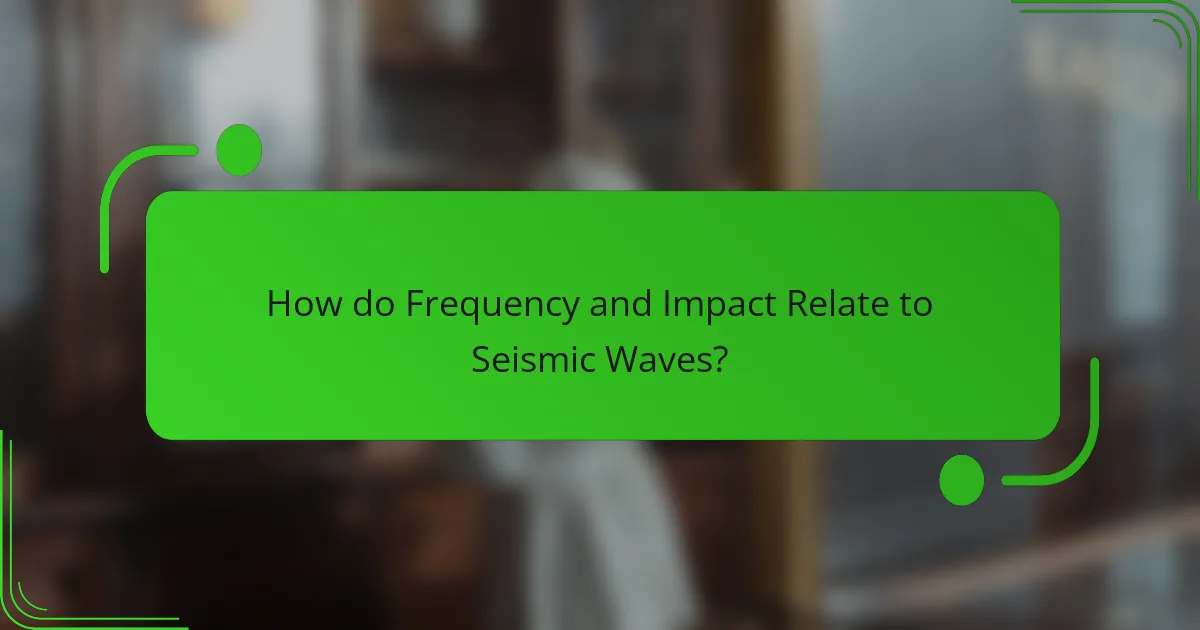
How do Frequency and Impact Relate to Seismic Waves?
Frequency and impact are critical characteristics of seismic waves. Frequency refers to the number of oscillations per unit time. Higher frequency waves tend to have shorter wavelengths. These waves can cause more intense shaking during an earthquake. Impact relates to the energy released during seismic events. Higher energy releases correspond to greater impact on structures and the environment. Research indicates that low-frequency waves penetrate deeper into the Earth. They can travel longer distances with less attenuation. Conversely, high-frequency waves dissipate energy quickly. This dissipation results in a more localized impact. Understanding these relationships helps in earthquake preparedness and building design.
What is the relationship between frequency and earthquake detection?
Frequency refers to the number of seismic wave cycles that occur in a given time period. In earthquake detection, frequency is crucial for identifying and analyzing seismic waves. Different types of seismic waves have distinct frequency ranges. For instance, primary (P) waves typically have higher frequencies, while secondary (S) waves have lower frequencies.
Seismometers detect these waves by measuring their frequency and amplitude. Higher frequency waves are often associated with smaller, more localized earthquakes. Conversely, lower frequency waves can indicate larger, more distant seismic events.
The relationship between frequency and earthquake detection is evident in how seismic data is processed. Analysis of frequency helps in determining the earthquake’s magnitude and depth. Research indicates that frequency analysis can improve early warning systems, allowing for quicker responses to seismic events.
How does frequency affect the interpretation of seismic data?
Frequency significantly affects the interpretation of seismic data. Higher frequencies provide more detailed information about small-scale geological features. They can reveal fine structures like fractures and faults. However, high-frequency waves are more susceptible to attenuation. This means they lose energy more quickly as they travel through the Earth. Lower frequencies penetrate deeper into the Earth. They are better for imaging larger geological structures. However, they may lack the resolution needed for detailed analysis. The choice of frequency directly influences the clarity and accuracy of seismic interpretations. For instance, studies show that varying frequency ranges can highlight different subsurface characteristics. This variability is crucial for effective earthquake detection and analysis.
What frequencies are most useful for detecting different types of earthquakes?
Low-frequency waves, typically below 1 Hz, are most useful for detecting large, distant earthquakes. These waves, known as seismic waves, can travel long distances. They provide valuable information about the earthquake’s magnitude and depth. High-frequency waves, above 1 Hz, are better for detecting local earthquakes. They offer detailed data about the earthquake’s location and characteristics. Research shows that different seismic sensors are tuned to specific frequency ranges. For example, broadband seismometers can capture a wide range of frequencies. This capability enhances the detection and analysis of various earthquake types.
What are the impacts of seismic waves on structures and communities?
Seismic waves significantly impact structures and communities during earthquakes. These waves cause ground shaking, which can lead to structural damage. Buildings may experience cracks, collapses, or even total failure depending on their design and materials. For example, the 1994 Northridge earthquake caused over $44 billion in damages in California. Communities may face disruption of services, such as electricity and water supply, following seismic activity. This can lead to prolonged recovery times and increased economic stress. Additionally, seismic waves can trigger landslides and tsunamis, further endangering lives and property. The extent of impact varies based on wave type, magnitude, and local geology.
How do seismic waves contribute to building damage during earthquakes?
Seismic waves contribute to building damage during earthquakes by transferring energy through the ground. These waves cause ground shaking, which exerts forces on structures. The intensity of shaking depends on wave type and frequency. Primary waves (P-waves) move quickly and compress materials, while secondary waves (S-waves) follow, causing more intense shaking. Surface waves, which travel along the ground, are often the most damaging. Buildings not designed to withstand these forces can suffer structural failure. For example, the 1994 Northridge earthquake caused over $40 billion in damage due to seismic wave impacts. Proper engineering can mitigate these effects by enhancing building resilience.
What measures can be taken to mitigate the impact of seismic waves?
To mitigate the impact of seismic waves, structural engineering measures can be implemented. These include base isolation systems that allow buildings to move independently from ground motion. Reinforced structures using materials like steel and concrete enhance resilience against seismic forces. Additionally, retrofitting existing buildings can improve their ability to withstand seismic activity. Land-use planning can also reduce risk by avoiding construction in high-seismic zones. Early warning systems provide alerts before seismic waves reach populated areas, allowing for timely evacuations or safety measures. These strategies have been proven effective in reducing damage and saving lives during earthquakes. For example, Japan’s earthquake-resistant buildings have significantly decreased casualties during seismic events.
What best practices should be followed for effective earthquake detection?
Effective earthquake detection requires a combination of advanced technology and established protocols. Installing a network of seismometers enhances the ability to detect seismic waves accurately. Regular calibration of these instruments ensures reliable data collection. Implementing real-time data analysis allows for immediate response to detected seismic activity. Collaboration with geological agencies improves data sharing and enhances detection capabilities. Training personnel in earthquake preparedness ensures appropriate responses during seismic events. Establishing public awareness programs informs communities about earthquake risks and safety measures. These best practices collectively improve the effectiveness of earthquake detection systems.
Seismic waves are energy waves produced by the sudden release of energy in the Earth’s crust, primarily during earthquakes. The article outlines the two main types of seismic waves—primary (P) waves and secondary (S) waves—and their roles in earthquake detection, including how they help determine an earthquake’s epicenter and magnitude. It discusses the characteristics of seismic waves, such as speed, frequency, and amplitude, and how these factors influence their impact on structures and communities. Additionally, the article covers the importance of seismic wave analysis in improving early warning systems and outlines best practices for effective earthquake detection.
